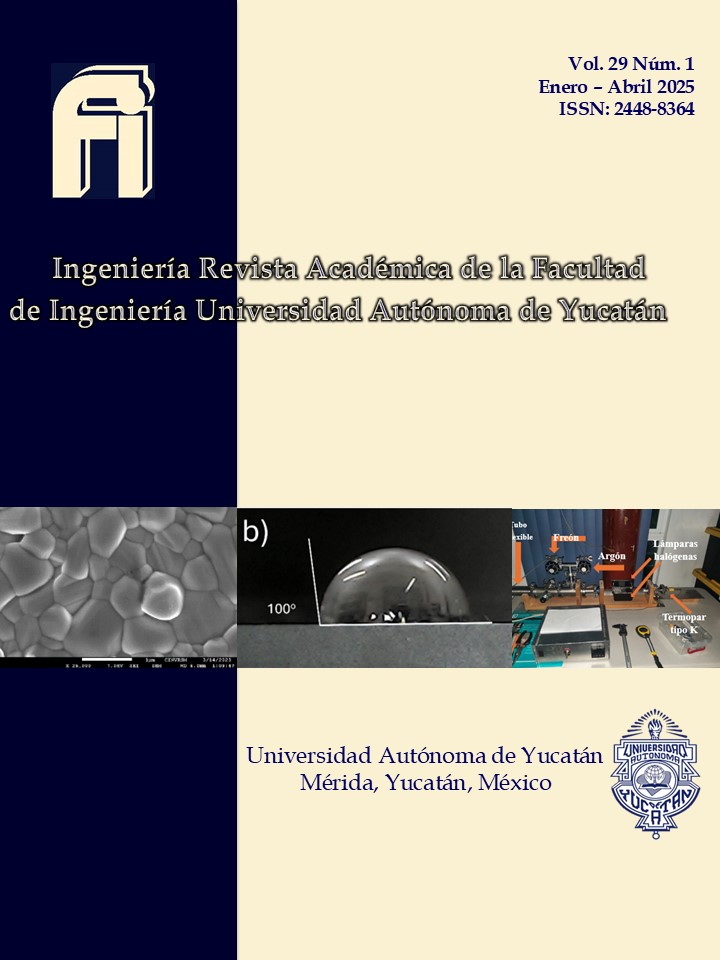Síntesis por Nebulizado de Superficies Hidrofóbicas, Durables y Antirreflectantes de SiO2/TiO2
Resumen
En este trabajo se realizó el estudio de parámetros de síntesis para obtener superficies antirreflectantes de capas simples y dobles de SiO2/TiO2 mediante la técnica de nebulización, aplicadas sobre vidrio conductor (TEC 15) y vidrio Corning. Para mejorar la hidrofobicidad, las capas de SiO2 fueron funcionalizadas con octadecil-triclorosilano (OTS) y trietoxi-octil-silano (OD8). Las propiedades de las películas fueron caracterizadas utilizando técnicas de UV-VIS, FTIR, difracción de rayos X, Raman y mediciones del ángulo de contacto entre una gota de agua y la superficie. Las mejores condiciones de síntesis se lograron con 20 PSI, 70°C y 4 segundos para las películas de SiO2, y 20 PSI, 400°C y 20 segundos para las capas de TiO2. La funcionalización con silanos, particularmente OD8 y OTS, mejoró significativamente la hidrofobicidad, obteniéndose películas compactas, continuas, con alta transmitancia y buena resistencia al agua. Estos resultados demuestran que la técnica de nebulización es efectiva para el depósito de películas delgadas con potencial para aplicaciones en superficies antirreflejantes e hidrofóbicas.
Abstract
In this work, synthesis parameters were studied to obtain anti-reflective surfaces of single and double layers of SiO2/TiO2 through the nebulization technique, applied on conductive glass (TEC 15) and Corning glass. The SiO2 layers were functionalized with octadecyl-trichlorosilane (OTS) and triethoxy-octyl-silane (OD8) to improve hydrophobicity. The properties of the films were characterized using UV-VIS, FTIR, X-ray diffraction, Raman spectroscopy, and contact angle measurements between a water droplet and the surface. The best synthesis conditions were achieved with 20 PSI, 70°C, and 4 seconds for SiO2 films, and 20 PSI, 400°C, and 20 seconds for TiO2 layers. The silane functionalization, particularly with OD8 and OTS, significantly improved hydrophobicity, resulting in compact, continuous films with high transmittance and good water resistance. These results demonstrate that the nebulization technique effectively deposits thin films with potential applications in anti-reflective and hydrophobic surfaces.
Citas
Ceballos-Chuc, M. C., Ramos-Castillo, C. M., Alvarado-Gil, J. J., Oskam, G., & Rodríguez-Gattorno, G. (2018). Influence of brookite impurities on the raman spectrum of TiO2 anatase nanocrystals. Journal of Physical Chemistry C, 122(34), 19921–19930. https://doi.org/10.1021/acs.jpcc.8b04987
Delgado, L. P., Figueroa-Torres, M. Z., Ceballos-Chuc, M. C., García-Rodríguez, R., Alvarado-Gil, J. J., Oskam, G., & Rodriguez-Gattorno, G. (2020). “Tailoring the TiO2 phases through microwave-assisted hydrothermal synthesis: Comparative assessment of bactericidal activity”. Materials Science and Engineering C, 117. https://doi.org/10.1016/j.msec.2020.111290
Doerr, S. H., Shakesby, R. A., & Walsh, R. P. D. (2000). Soil water repellency: its causes, characteristics and hydro-geomorphological significance. In Earth-Science Reviews (Vol. 51). www.elsevier.comrlocaterearscirev
Feng, J. Q. (2018). A computational analysis of gas jet flow effects on liquid aspiration in the collison nebulizer. Proceedings of the 5th International Conference on Fluid Flow, Heat and Mass Transfer, 180. https://doi.org/10.11159/ffhmt18.180
Li, H., Li, N., Zhang, Y., He, H., & Liu, Z. (2017). Anti-reflection OTS-treated SiO2 thin films with super-hydrophobic property. Journal of Sol-Gel Science and Technology, 83(3), 518–526. https://doi.org/10.1007/s10971-017-4458-0
Ran, M., Zheng, W., & Wang, H. (2019). Fabrication of superhydrophobic surfaces for corrosion protection: a review. In Materials Science and Technology (United Kingdom) (Vol. 35, Issue 3, pp. 313–326). Taylor and Francis Ltd. https://doi.org/10.1080/02670836.2018.1560985
Reyes-Coronado, D., Rodríguez-Gattorno, G., Espinosa-Pesqueira, M. E., Cab, C., De Coss, R., & Oskam, G. (2008). Phase-pure TiO2 nanoparticles: Anatase, brookite and rutile. Nanotechnology, 19(14). https://doi.org/10.1088/0957-4484/19/14/145605
Wu, G., Yang, T., Wang, J., Zhang, H., Shen, J., Fan, B., Zhou, D., & Zhang, F. (2000). Nanoporous silica antireflective coatings for solar heat collectors. High Temperatures - High Pressures, 32(6), 687–692. https://doi.org/10.1068/htwu176
Xiaolin, L., Weiqing, Z., Yueqin, L., Yongxing, T., Jinren, S., & Peihui Liang. (2000). Influence of H2O on structure of base-catalyzed porous SiO2 antireflective coatings. Acta Photonica Sinica, 29, 1035–1039.
Zäll, E., Järn, M., Karlsson, S., Tryggeson, H., Tuominen, M., Sundin, M., & Wågberg, T. (2023). Aerosol-based deposition of broadband antireflective silica coating with closed mesoporous structure. Solar Energy Materials and Solar Cells, 250. https://doi.org/10.1016/j.solmat.2022.112078
Zhang, Y., Zhang, X., Ye, H., Xiao, B., Yan, L., & Jiang, B. (2012). A simple route to prepare crack-free thick antireflective silica coatings with improved antireflective stability. Materials Letters, 69, 86–88. https://doi.org/10.1016/j.matlet.2011.11.043
Zhao, X., Zhao, Q., Yu, J., & Liu, B. (2008). Development of multifunctional photoactive self-cleaning glasses. Journal of Non-Crystalline Solids, 354(12–13), 1424–1430. https://doi.org/10.1016/j.jnoncrysol.2006.10.093

Esta obra está bajo licencia internacional Creative Commons Reconocimiento-NoComercial 4.0.
Avisos de derechos de autor propuestos por Creative Commons
1. Política propuesta para revistas que ofrecen acceso abierto
Aquellos autores/as que tengan publicaciones con esta revista, aceptan los términos siguientes:
- Los autores/as conservarán sus derechos de autor y garantizarán a la revista el derecho de primera publicación de su obra, el cuál estará simultáneamente sujeto a la Licencia de reconocimiento de Creative Commons que permite a terceros compartir la obra siempre que se indique su autor y su primera publicación esta revista.
- Los autores/as podrán adoptar otros acuerdos de licencia no exclusiva de distribución de la versión de la obra publicada (p. ej.: depositarla en un archivo telemático institucional o publicarla en un volumen monográfico) siempre que se indique la publicación inicial en esta revista.
- Se permite y recomienda a los autores/as difundir su obra a través de Internet (p. ej.: en archivos telemáticos institucionales o en su página web) antes y durante el proceso de envío, lo cual puede producir intercambios interesantes y aumentar las citas de la obra publicada. (Véase El efecto del acceso abierto).

